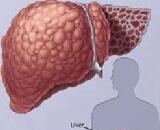Liver Cirrhosis (LC)
Cirrhosis; Hepatic cirrhosis

Liver cirrhosis is defined as the histological development of regenerative nodules surrounded by fibrous bands in response to chronic liver injury, which leads to portal hypertension and end-stage liver disease. Cirrhosis is most commonly caused by alcohol, hepatitis B, hepatitis C, and non-alcoholic fatty liver disease. Non-alcoholic fatty liver disease is due to a number of reasons, including being overweight, diabetes, high blood fats, and high blood pressure. A number of less common causes include autoimmune hepatitis, primary biliary cirrhosis, hemochromatosis, certain medications, and gallstones. Cirrhosis is characterized by the replacement of normal liver tissue by scar tissue.
Organism species: Mus musculus (Mouse)
- Disease model DSI554Mu01 Mouse Model for Liver Cirrhosis (LC) In Stock
- Disease model DSI554Mu02 Mouse Model for Liver Cirrhosis (LC) In Stock
- Disease model DSI554Mu03 Mouse Model for Liver Cirrhosis (LC) In Stock
- Disease model DSI554Mu04 Mouse Model for Liver Cirrhosis (LC) In Stock
- Disease model DSI554Mu05 Mouse Model for Liver Cirrhosis (LC) In Stock
- Disease model DSI554Mu06 Mouse Model for Liver Cirrhosis (LC) In Stock
- Customized Service n/a Tissue of Liver Cirrhosis (LC) (If Necessary) Tissue Customized Service Offer
- Customized Service n/a Serums of Liver Cirrhosis (LC) (If Necessary) Serums Customized Service Offer
Organism species: Rattus norvegicus (Rat)
- Disease model DSI554Ra01 Rat Model for Liver Cirrhosis (LC) In Stock
- Customized Service n/a Tissue of Liver Cirrhosis (LC) (If Necessary) Tissue Customized Service Offer
- Customized Service n/a Serums of Liver Cirrhosis (LC) (If Necessary) Serums Customized Service Offer
Organism species: Cavia (Guinea pig )
- Customized Service n/a Model for Liver Cirrhosis (LC) Disease Model Customized Service Offer
- Customized Service n/a Tissue of Liver Cirrhosis (LC) (If Necessary) Tissue Customized Service Offer
- Customized Service n/a Serums of Liver Cirrhosis (LC) (If Necessary) Serums Customized Service Offer
Organism species: Oryctolagus cuniculus (Rabbit)
- Disease model DSI554Rb01 Rabbit Model for Liver Cirrhosis (LC) In Stock
- Disease model DSI554Rb06 Rabbit Model for Liver Cirrhosis (LC) In Stock
- Customized Service n/a Tissue of Liver Cirrhosis (LC) (If Necessary) Tissue Customized Service Offer
- Customized Service n/a Serums of Liver Cirrhosis (LC) (If Necessary) Serums Customized Service Offer
Organism species: Canis familiaris; Canine (Dog)
- Disease model DSI554Ca01 Canine Model for Liver Cirrhosis (LC) In Stock
- Tissue TSI554Ca03 Canine Tissue of Liver Cirrhosis (LC) In Stock
- Customized Service n/a Serums of Liver Cirrhosis (LC) (If Necessary) Serums Customized Service Offer


